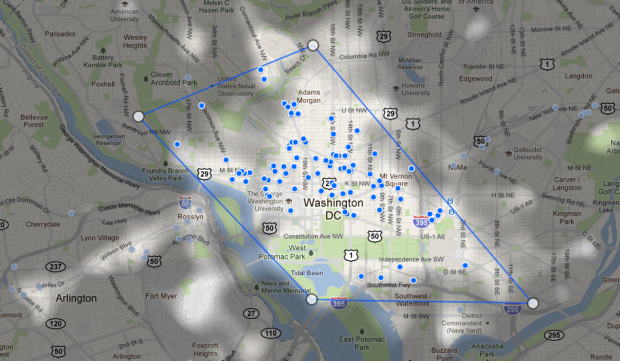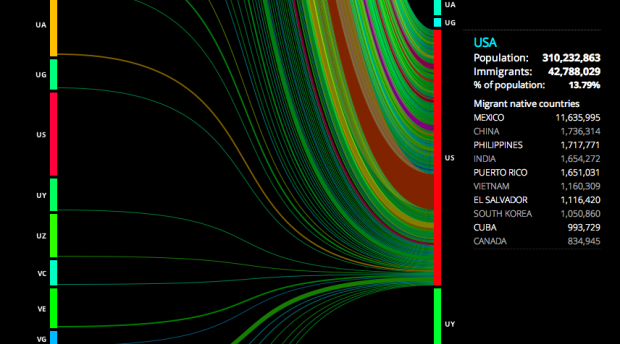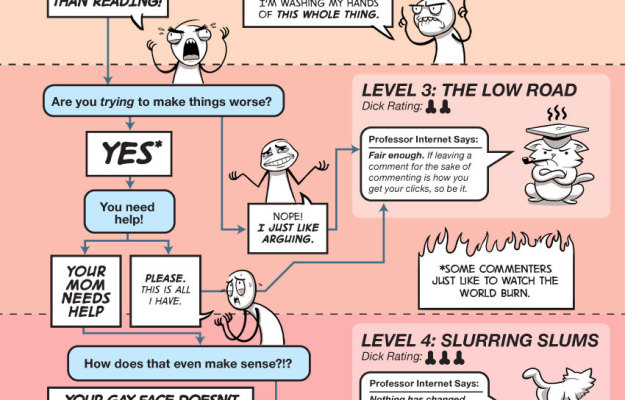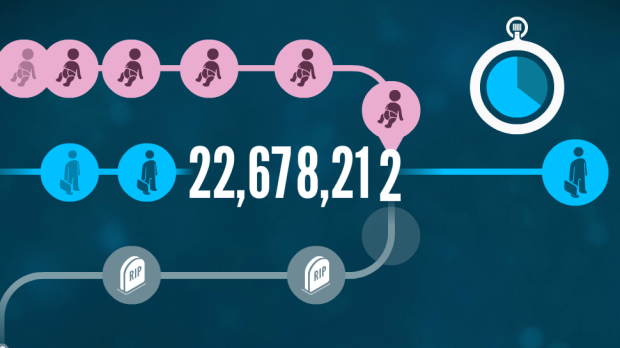The two differ in who uses them, how they are used, and who consumes them. They have the same goal. It’s to better understand data. You’d think that common bond would draw statisticians and information visualization researchers together for ample collaboration, but that isn’t the case. You see, each group doesn’t quite understand what the other is doing, and that’s where intermingling gets tricky.
Read More
-
-
I’m visiting the US Census Bureau this week, so there’s a good chance there will be a few days I don’t post anything. Hopefully not though. I have a couple of things scheduled. But in case I go radio silent for a few days, you’ll know why. It’ll be back to normal next week.
-
The food nutrition label is on almost every food item, but it can be confusing in the sense that it doesn’t tell you much about whether something is good or bad for you. The UC Berkeley School of Journalism hosted a challenge for designers and food experts to rethink the label:
We are confused about what and how to eat and so we’re eating too much of the wrong things. In fact, we’re eating too much of everything. Two-thirds of American adults are overweight or obese. The obesity rate among preschoolers has doubled since 1970. Type 2 diabetes has become an epidemic. We want to make it easier to choose healthy food.
Visual designer Renee Walker won with her rework shown above. The rectangles on top of each label represent main ingredients, and bars on the bottom provide a quick thumbs or thumbs down for a breakdown of fat content, carbohydrates, etc. Icons of spoons and scoops are used to supplement serving size since no one knows what 182 grams looks or feels like.
Practically speaking, it’s hard to imagine anything like this on the back of a Snickers bar any time soon. It requires a certain amount of space to be useful. The sentiment, however, is good and there are useful bits that could be used in a redesign in the future.
How would you improve the existing nutrition label?
[Rethink the Food Label | Thanks, Jeffrey]
-
In an interview with Enrico Bertini, Moritz Stefaner, whose work you’ll probably recognize, talks about his experiences as a freelancer and how he got started. Some of the highlights include how to get your name out there, important skills, and the demand for people who know data, visualization, and aesthetics. At nearly an hour long, there’s a lot of good information in there.
The main takeaway: get started now, play with data, hone your skills, and the work will come.
-
Maryalene LaPonsie describes some novel job called Data Scientist (although we’ve known about it for a while) and their role in competitive intelligence:
Competitive intelligence is poised to offer data scientists increasing job opportunities in coming years. SCIP reports that the market for business intelligence is worth approximately $2 billion annually, and Garrison says that many corporations now operate their own competitive intelligence divisions.
Plus there’s a shortage of an estimated 140,000 to 190,000 people who are qualified for the openings available (not all in business). What you need to know to get hired:
As part of a relatively new field, data scientists may come from many different backgrounds. Garrison says that employers are often looking for two things when considering a job applicant. “The first part is the technical background,” he says. Companies may want professionals with an industry background who are familiar with its specific jargon and trends. “If you want to work for a pharmaceutical company, you might need a degree in biochemistry,” he explains. Other jobs may require only a general degree in business.
In other words, you need to know statistics and know or be able to learn about the subject matter. Programming skills are a plus. Actually, programming is required. I don’t know any data scientists who don’t have that skill. I hear there’s some book to help you get started though.
[AOL Jobs via @alexlundry]
-
When you’re picking a hotel to stay at in an area you don’t know well, the place you end up at can be arbitrary. With most travel sites, you get a list of hotels with ratings, which is helpful, but still feels confusing at times. Sites like Hipmunk aim to make the search easier. Most recently Google launched a new experiment called Hotel Finder.
Read More -
Joan R. Ginther has won the lottery four times, each time with million dollar payouts. Either she’s the luckiest woman in the world, or her wins have to do with her statistics PhD. I suspect the latter. (And I need to get my hands on a lottery dataset.)
[Thanks, Ryan]
-
Hundreds of thousands of people immigrate every year, with some countries seeing higher rates than others. To compare and to gain a better sense of the number of people moving around, Carlo Zapponi created peoplemovin.
Read More -
-
Using data from the USPS Postmaster Finder and the USGS Geographic Names Information System, geography graduate student Derek Watkins maps the opening of new post offices from 1700 to 1900. As you know, the mail must go through. No matter if it rains or snows. The mail must go through. So it’s also a great way to see expansion of the US.
Some interesting spots: In 1776, after the revolution, new offices open along the east coast; in 1848, during the gold rush, offices sprout up on the west coast; in the 1870s, offices along the railroad open up.
-
 One of the best parts since the launch of Visualize This has been the pictures that people have sent me of the book in the wild. It makes it feel all the more real.
One of the best parts since the launch of Visualize This has been the pictures that people have sent me of the book in the wild. It makes it feel all the more real.To have some fun with it, let’s have a little contest. Take a picture of the book in your hands, on your desk, or wherever you like really, and send it to [email protected] by this Friday, August 12, 2011. If you have a digital version, feel free to take a picture of your iPad or Kindle with the book open. I’ll put all the pics together in a mosaic or something.
Then I’ll choose five winners at random, and you can pick any print book you like from the Wiley Tech library (minus box sets). Good luck!
-
-
Personal data collection can be a tough sell at times, but with the Nike+, which lets you record your runs, thousands have taken part in measuring their performance and digitally racing with others. For the most recent Nike+ campaign, interactive collective YesYesNo mapped a year’s worth of runs from the Nike+ site and invited people to plug in their own runs.
Read More -
 Jonathan Stark, a mobile application consultant, is running an interesting social experiment with his Starbucks card:
Jonathan Stark, a mobile application consultant, is running an interesting social experiment with his Starbucks card:Jonathan’s Card is an experiment in social sharing of physical goods using digital currency on mobile phones. I stumbled on the idea while doing research for a blog post about Broadcasting Mobile Currency.
Based on the similarity to the “take a penny, leave a penny” trays at convenience stores in the US, I’ve adopted a similar “get a coffee, give a coffee” terminology for Jonathan’s Card.
Simply save the picture of Jonathan’s Starbucks card onto your smartphone and use it to buy your coffee. If you like, add money to the card so that someone else can buy a coffee.
The best part is that Stark provides a simple API that returns the balance on the card every minute. When do people buy coffee? How do people give and take? Are people more likely to give when there’s a large balance or when there’s nothing left? Lots of fun things to look at.
[Jonathan’s Card via @kn0thing]
-
FlowingData’s readership continues to grow (which is great), but that also means it takes more to keep the lights on here. A big thank you to FlowingData sponsors for helping me make sure FlowingData stays up and running smoothly. Check ’em out. They help you do good stuff with data.
IDV Solutions Visual Fusion — Business intelligence software for building focused apps that unite data from virtually any data source in a visual, interactive context for better insight and understanding.
Tableau Software — Combines data exploration and visual analytics in an easy-to-use data analysis tool you can quickly master. It makes data analysis easy and fun. Customers are working 5 to 20 times faster using Tableau.
Column Five Media — Whether you are a startup that is just beginning to get the word out about your product, or a Fortune 500 company looking to be more social, they can help you create exciting visual content – and then ensure that people actually see it.
InstantAtlas — Enables information analysts and researchers to create highly-interactive online reporting solutions that combine statistics and map data to improve data visualization, enhance communication, and engage people in more informed decision making.
Want to sponsor FlowingData? Send interest to [email protected] for more details.
-
With the anonymity on the Internet and all, I know it can be a tough decision whether you should be a trolling troll or not. H. Caldwell Tanner and Rosscott Nover help you figure it all out with this comical flowchart.
[Rosscott, Inc. via Laughing Squid]
-
The Economist updates their Big Mac Index, which as we all know, is the most accurate way to measure the global economy:
It is based on the theory of purchasing-power parity (PPP), the notion that in the long run exchange rates should move towards the rate that would equalise the prices of a basket of goods and services around the world. At market exchange rates, a burger is 44% cheaper in China than in America. In other words, the raw Big Mac index suggests that the yuan is 44% undervalued against the dollar. But we have long warned that cheap burgers in China do not prove that the yuan is massively undervalued. Average prices should be lower in poor countries than in rich ones because labour costs are lower. The chart above shows a strong positive relationship between the dollar price of a Big Mac and GDP per person.
When adjusted for GDP, we can see where Big Macs are actually expensive: Brazil, Argentina, and Sweden. I guess there’s a premium on special sauce over there.
[The Economist via kottke]
-
A couple of weeks ago, Visually, a new infographics-based startup, launched with a warm reception among all the popular tech blogs. I didn’t post about it right away for a couple of reasons. The first is that I’ve been sick for the past couple of weeks, and it’s been hard to think in between all the nose-blowing. Seriously, this cold will not die. Secondly, I wasn’t sure how I felt about the new site (partially due to the first reason). Now that I’ve let my thoughts simmer, it’s clear that Visually has potential, but it’s way too early to tell if it will actually work.
Read More -
Census is any country is important in making major policy decisions and can affect your day-to-day, but it’s not always obvious how. Leading up to the August 9 Australia Census, the Australian Bureau of Statistics put together an interactive called Spotlight, which helps its citizens understand the data a little better.
Read More -
Paul Bourke, a research professor at the University of Western Australia, provides us a fly-through of the known universe, according to the 6dF Galaxy Survey:
The 6dF Galaxy Survey has collected more than 120,000 redshifts over the southern sky over a 5 year period from 2001 to 2005. Its goal is to map our southern view of the local universe, and use the peculiar motions of one-tenth of the survey to measure galaxy mass. It covers more than eight times the sky area of the successful 2dF Galaxy Redshift Survey.
Watch the animation in all its glory below as it moves to the edge of the data.
Read More










 Visualize This: The FlowingData Guide to Design, Visualization, and Statistics (2nd Edition)
Visualize This: The FlowingData Guide to Design, Visualization, and Statistics (2nd Edition)










